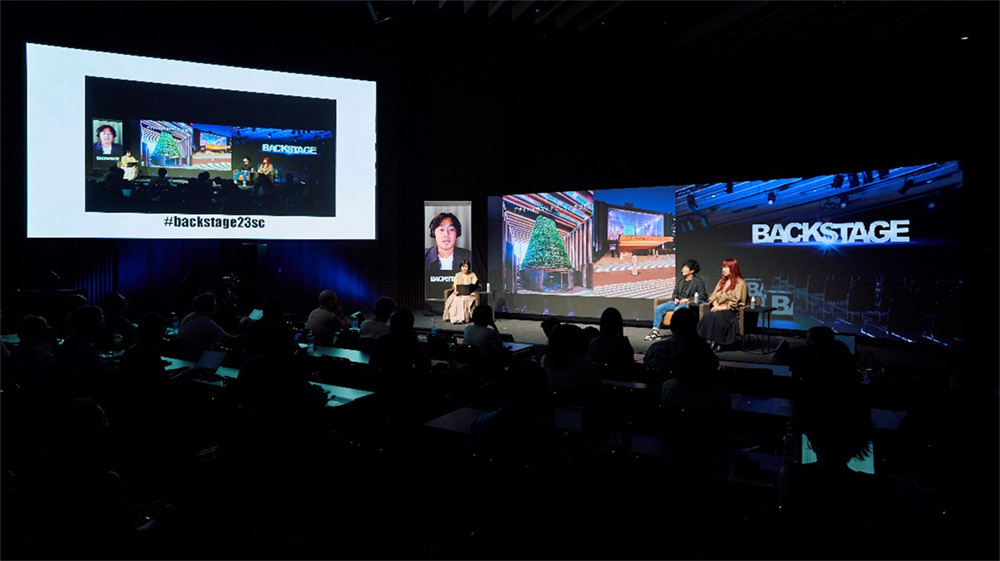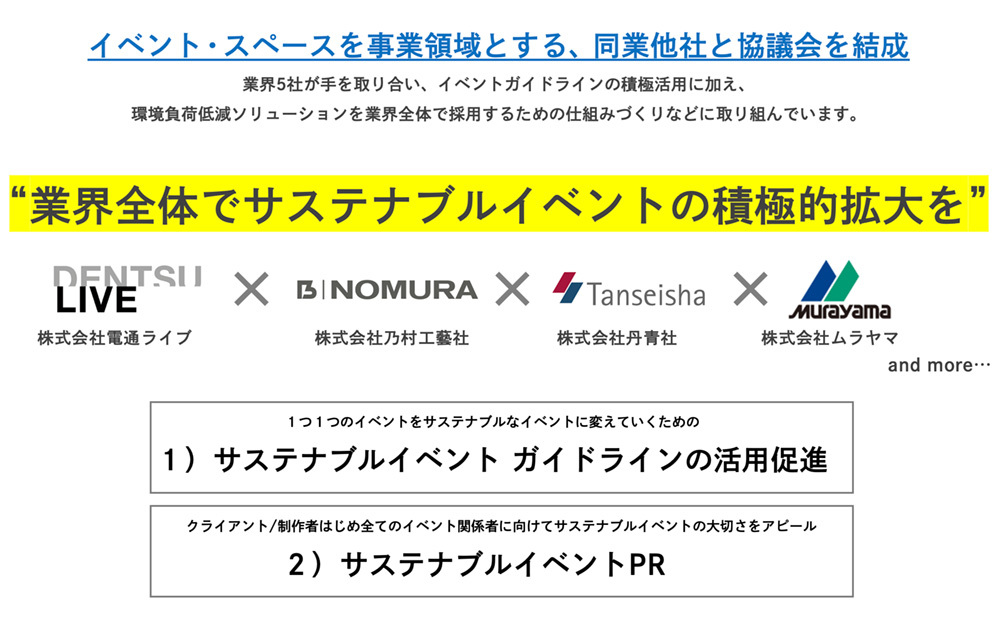The term "sustainability" and its importance are widely recognized, but are these concepts truly translating into action? What specific challenges exist in promoting sustainability within the fields of space creation and events? To explore the reality of this situation and find hints for solutions, three individuals engaged in corporate sustainability initiatives shared their insights, incorporating original research and international case studies.
*This article is based on a session from the "BACKSTAGE" conference held in August 2023. https://backstage.tours/

Interviewer: Yoko Higuchi (Editor-in-Chief, Monthly Event Marketing)
Sustainability Promotion: From Obligation to Corporate Growth Strategy
――First, please introduce yourselves.
Takashima: At Dentsu Inc., I lead the "Dentsu Team SDGs" project team, which supports stakeholders' SDGs initiatives. I also assist various companies and media outlets with strategy development, business transformation, and communication related to advancing sustainability.
Ōtaka: I work at Dentsu Live Inc., which primarily handles event operations. For about 20 years since my previous job, I've been a producer in the event space division. I only started seriously engaging with sustainability last year, so I'm still in the early stages. I hope to share insights that resonate with others in the same position.
Nishizaki: I operate a platform called the " Sustainable Event Network" at Japan Greyline. There, I help everyone involved in events learn together, aiming to make the entire event industry sustainable. Currently residing in the Netherlands, I hope to share insights from my dual perspective working in both the Netherlands and Japan.
――Before diving into sustainability in promotion and events, could Mr. Takeshima first give us an overview of the broader sustainability landscape?
Takashima: Since this is an introduction, I'll just cover the key points. First, consumer awareness.
According to Dentsu Inc.'s proprietary survey, awareness of the term "SDGs" stands at 91.6%, while awareness of "carbon neutral" has risen to 85.4%. Furthermore, approximately 76% of respondents feel there is a necessity for initiatives to achieve carbon neutrality. This indicates that among consumers, awareness has grown beyond mere recognition to a sense of urgency that action is required. 
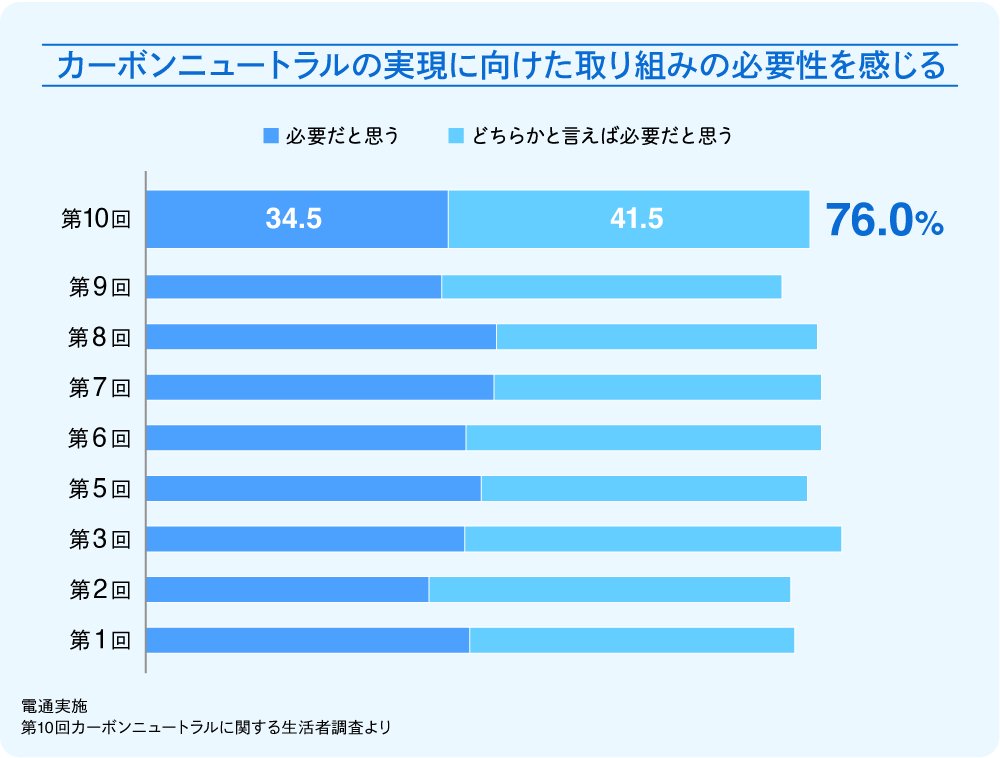
Another noteworthy finding concerns "perceptions of companies engaged in SDGs." Results indicate that "the company's image improves/favorability increases/trust grows" and "consumers are more likely to purchase/use that company's products or services." This suggests that SDG engagement not only enhances a company's image but also positively impacts its business. 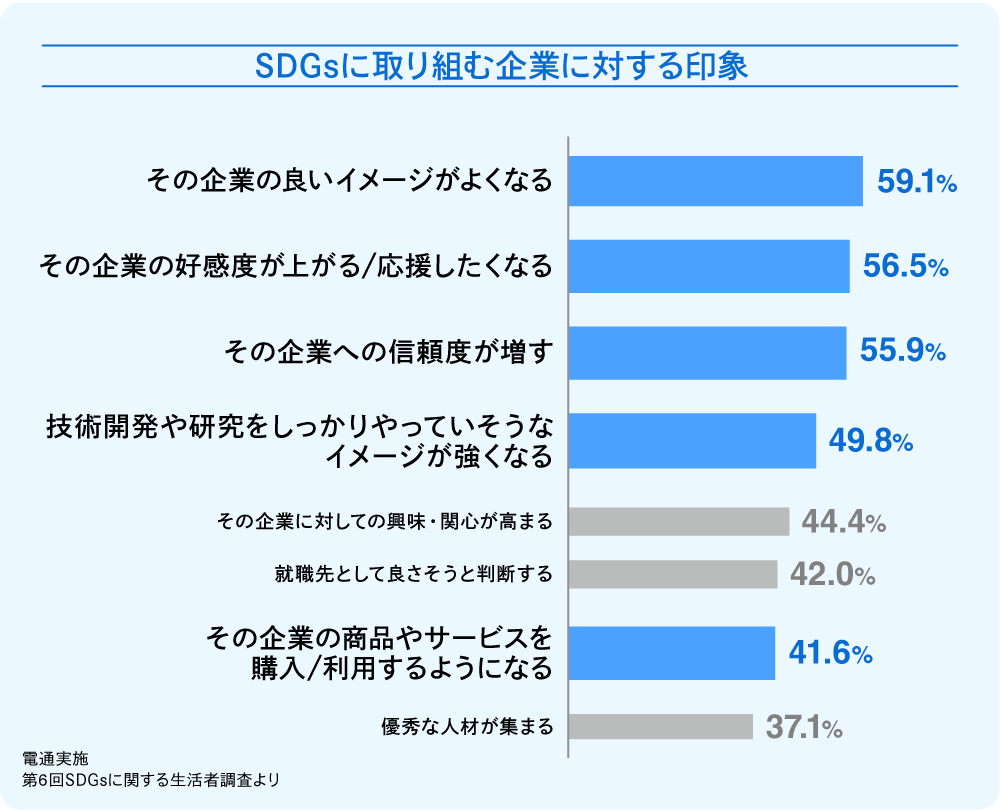
Next, let's examine the SDG landscape from the corporate perspective.
Why should companies across all industries prioritize sustainability now? As mentioned earlier, it's not just about enhancing consumer perception and becoming a preferred company. Failure to engage poses operational risks, such as declining investor evaluations. Moreover, heightened consumer awareness correlates with heightened employee awareness. Engaging in sustainability is crucial for talent acquisition, retention, and development. In essence, companies that don't engage are unlikely to survive in today's era.
So, what should companies focus on when starting with sustainability? One area is "where the company must fulfill its responsibilities. " In other words, this is what they must do. Are you familiar with "Scope 1, 2, and 3"? Beyond their own operations, companies must calculate and reduce all greenhouse gas emissions occurring throughout their business activities' supply chain—from sourcing raw materials and manufacturing products, to consumers purchasing, using, and disposing of them. Regarding this theme of events and space creation, companies now bear responsibility as part of the supply chain—through branding, marketing, etc.—making greenhouse gas reduction an obligation.

Source: Created
based on https://www.enecho.meti.go.jp/about/special/johoteikyo/scope123.html
"Scope 1" refers to greenhouse gases directly emitted by the company itself. "Scope 2" refers to greenhouse gases indirectly emitted through the use of electricity, heat, or steam supplied by other companies. "Scope 3" refers to greenhouse gases emitted during raw material procurement or after sales. Advertising and events fall under "Scope 3".
Another increasingly important aspect is initiatives that go beyond mandatory obligations , leveraging the company's unique strengths to enhance corporate value and profitability. This involves defining the company's value and strengths, developing sustainable products and businesses based on them, and engaging employees and consumers to transform behaviors and implement solutions in society. In other words, sustainability promotion is not just an obligation; it has become crucial for business growth.
To drive sustainability in a way that fuels business growth, the following are essential:
・Re-evaluating all aspects of the business from a sustainability perspective
・Inspiring and mobilizing both internal stakeholders (employees) and consumers to act together
・Creating communication, spaces, and systems that allow employees and consumers to genuinely feel the necessity and value of sustainability, enabling them to enjoy and sustain these efforts
We believe that events and space design can serve as engines for sustainability promotion, particularly in enabling this "enjoyable and sustainable" approach.
Learning from the Netherlands: "Design × Sustainability" Planning
――Thank you. Now, regarding what sustainability in event and space creation specifically entails, I'd like Mr. Nishizaki to share the latest international examples.
Nishizaki: Let me share the example of the Netherlands Pavilion at Expo 2020 Dubai. The Netherlands has a strong foundation for "enjoying design × sustainability," and this pavilion gained global attention as an excellent example. It utilized solar power to extract hundreds of liters of water daily from the atmosphere. Visitors experienced an entertainment feature where they stood under umbrellas, receiving this water as it rained down upon them, accompanied by music and visuals. Sustainability was integrated into this pavilion from the construction phase. After the Expo concluded, the building materials used were reportedly returned to the local construction industry. As a result, it won numerous awards as the most sustainable pavilion.
Next is the example of Blue City, an office complex housing circular economy-related companies. This office is constructed using upcycled waste materials. As you can see in the image, the window frames are curved, right? Actually, they were straight in the design plans, but the dimensions of the upcycled building materials available were longer. So, the designers and craftsmen discussed it on-site and solved the issue by creating a design with angles. I think this is a clear example of achieving sustainability through high design quality.

BlueCity_credit the photographer: Sophie de Vos
Finally, an event example: the world's first large-scale music festival to achieve zero waste, the "digital music festival." While people often assume this succeeded because of high Dutch environmental awareness, the opposite is true—participation is actually very low precisely because it's a sustainability-focused event. Its appeal as a music festival is the top priority, and attendees contribute to zero waste without even realizing it.
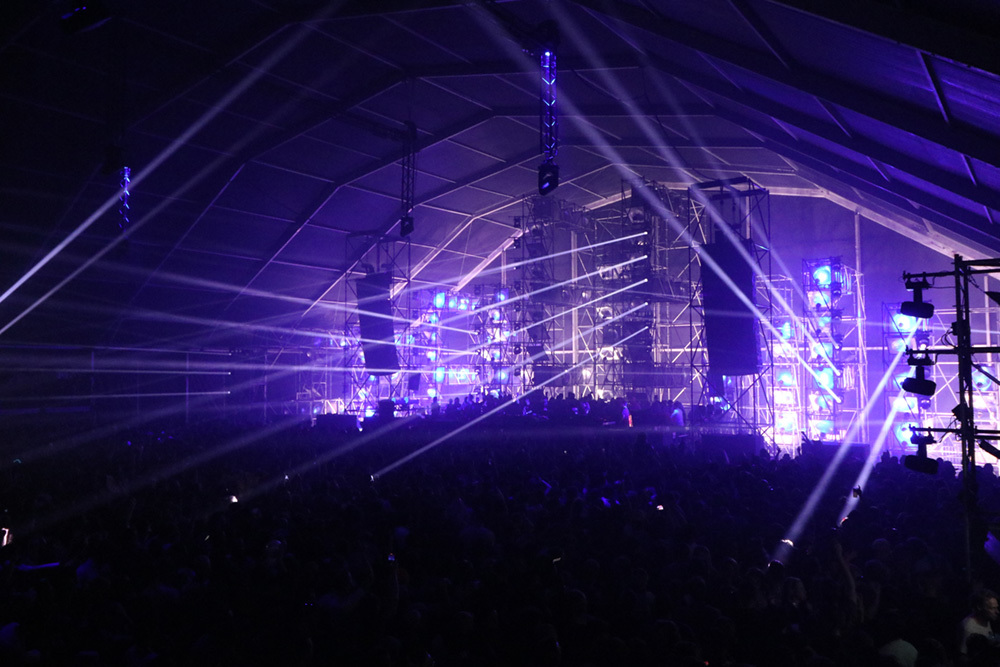
Photo by Ryuichiro Nishizaki
Takushima: I imagine initiatives like this are difficult to implement without actively involving consumers. What specific approaches were taken?
Nishizaki: The event incorporates these efforts into its experience design. For example, drink cups are reusable hard cups, and a system allows refills using the same cup multiple times. Returning the cup earns a token-like coin, and collecting these coins provides incentives like downloading unreleased music. Furthermore, to lower the barrier for returning cups, staff members are stationed throughout the venue. You can simply hand your cup to them to receive your coin. Since the music experience is the top priority, you can return your cup without interrupting that experience.
In other words, I believe the key point in event design is prioritizing the experience participants seek and then naturally integrating sustainability into that experience.
――Thank you. Mr. Otaka, I'd like to ask about examples in Japan.
Ōtaka: Compared to the Netherlands, we're still in the early stages, but some advanced examples are emerging. For instance, Itochu Corporation's "ITOCHU SDGs STUDIO," established in 2021. It features spaces like "Star Kitchen," where visitors engage with sustainability through food; "KIDS PARK," where children can interact with the SDGs; and "Children's Perspective Cafe," where adults can experience the world from a child's viewpoint. It was created not just for the company itself, but as a place to inspire everyone in society to engage with the SDGs in ways that suit them.

I also sense that facilities centered around sustainability, spearheaded by companies, are gradually increasing in Japan.
The biggest challenge in promoting sustainability is "personalization."
――While permanent facilities are advancing sustainability initiatives, what about events? From your perspective on the event front lines, Mr. Otaka, could you share the challenges in promoting sustainability at events?
Ōtaka: As I mentioned in my introduction, I only started seriously considering this myself around last year. From that perspective, I believe "personalization" is extremely important.
Sustainable practices are advancing in the process of creating our own products. However, at events promoting those products, sustainability is often not considered. I find this very wasteful. It's a missed opportunity that, despite creating products with sustainable thinking, sustainability isn't practiced at the very PR events where we most interact with consumers.
Working with clients at Dentsu Live Inc., I also felt the challenge of 'personalizing sustainability.' That's why we formed an internal sustainability team and are implementing two initiatives, which I'd like to share.
The first is our "Sustainability-Conscious Event Guidelines and Checklist." We created versions for environmental considerations and DEI (Diversity, Equity, and Inclusion). While "guidelines" might conjure images of a rulebook, that's not what this is. We designed it as a communication tool for event creators—organizers, sponsors, planners, and producers—to discuss how they can make their events more sustainable.
――So it's not something you consult last as an operational manual, but rather something you look at first to start a conversation, right?
Ōtaka: Exactly. The reason it's not a rulebook is that approaches to sustainability vary widely—there's no single right answer. There's also more than one area to tackle. Within the environment, for example, there's "waste reduction" and "energy conservation"; within DEI, there's "universal design" and "gender issues." The guidebook aims to first make people aware of these things and encourage them to take a step toward what they can tackle.
The key point is that you don't need to aim for perfection right away. It's important to take that first step, decide how far you'll go this time, reflect on it, and then decide how far to go next time. Repeating this cycle of reflection and action is crucial. I hope that by doing this gradually, we can build events that are increasingly mindful of sustainability.
――So starting with evaluation is okay too, right?
Ōtaka: Yes, that's right. I believe the key is to pursue continuous improvement, no matter which step you start with. This guideline itself isn't finished either. We really hope people will use it and give us feedback. We want to nurture this guideline, just as we want to nurture sustainable events in Japan together.
――I understand that Mr. Nishizaki and Mr. Takeshima were also involved in creating these guidelines. What did you contribute?
Nishizaki: In addition to incorporating globally standard items into the checklist, I focused on ensuring the scope of initiatives was comprehensive.
Takishima: From my role overseeing overall sustainability communication, I shared key considerations. Sustainability communication must be actively shared externally to convey value, but without sufficient substance or data, it becomes greenwashing and can actually damage the brand. Events are similar. For example, if an ad promotes positive values but the event hands out tons of plastic products and lacks DEI considerations... that can severely damage brand image, right? Precisely because these are touchpoints with consumers, certain aspects require caution, so we incorporated that perspective.
On the other hand, I believe sharing information like, "We're starting initiatives like this at our events," can also enhance corporate value. So, I think it would be great to use these guidelines while simultaneously communicating this information externally.
――The idea that this isn't a rulebook but a communication tool really struck me. I thought aligning everyone's perspective would be crucial initially. That also ties into solving cost issues, right? From both the risk management and information dissemination perspectives, I felt this guideline was vital. Could you tell us about another initiative?
Ōtaka: Four major players in the event space industry—Nomura Kōgeisha, Tanseisha, Murayama, and Dentsu Live Inc.—formed the "Sustainable Event Council" (Editor's note: Hakuhodo Products later joined, bringing the council to five members). What any single company can achieve alone is limited. While these companies sometimes compete with each other, we plan to actively utilize the guidelines mentioned earlier and collaborate on various initiatives to advance sustainability within the industry. I believe the challenge of "personalizing sustainability" applies equally to event production companies. Through this council, we aim for industry players to actively participate, collaborate, and help sustainable events become firmly established.
――Finally, I'd like to ask everyone for a hint that could lead to sustainable action.
Takashima: Sustainability challenges are vast and complex. As mentioned earlier, it's crucial not just for individual companies but for businesses to collaborate. We also need to engage consumers and transform society as a whole. To achieve this, initiatives must resonate emotionally with people and be exciting enough for everyone to participate in and sustain over time. I have high hopes that creating experiential events and spaces can become a major engine for driving sustainability forward, and I want to be part of making that happen.
Nishizaki: When I told someone in the Netherlands that their country is advanced in sustainability, they replied, "But Japan has been doing it for a thousand years, right?" They were referring to the Ise Grand Shrine's Shikinen Sengu ritual. Cultivating forests over centuries, using those trees for construction, rebuilding every 20 years to pass down techniques and traditions. In modern terms, it's about preserving a legacy.
Reflecting on such traditions, and observing both the Netherlands and Japan, I feel Japan still holds immense potential. While today's discussion may suggest the Netherlands is ahead, Japan excels in many technologies and solutions. I believe Japan could hit a game-changing home run. I think the event industry is where this could happen.
Ōtaka: I wonder if one reason people can't "make it their own" is fear holding them back from taking that first step? When studying sustainability, the phrase "Learning by doing" often comes up. Japan tends to have a mindset of learning thoroughly before acting. Instead, we should just start moving while learning. I believe that's crucial for developing sustainable events.
We've started initiatives like guidelines and councils, and I expect we'll face various failures ahead. But we'll learn from them and apply those lessons next time. I hope that in five or ten years, sustainability will be naturally ingrained in Japan's events and space creation.
――This session provided valuable insights into how the event sector should adapt and evolve as sustainability shifts phases. Personally, once BACKSTAGE concludes, I plan to start by implementing the guidelines. Let's all work together on this. Thank you for today.
